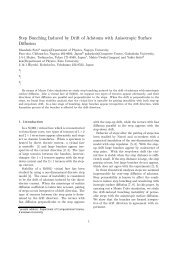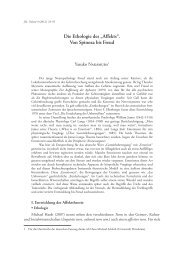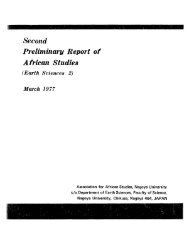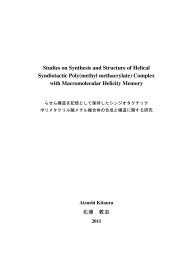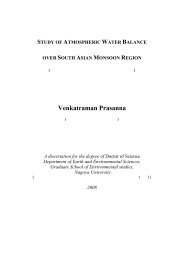k9254.pdf
k9254.pdf
k9254.pdf
Create successful ePaper yourself
Turn your PDF publications into a flip-book with our unique Google optimized e-Paper software.
3.2.3. Synthesis of PNIPA-COOH.<br />
PNIPA-N3 (20.0 mg, 0.0655 mmol) and 4-ethanoic benzoic acid (173 mg, 1.31 mmol) were<br />
dissolved in dry DMF (0.3 mL) and to this were added L-ascorbic acid (23.1 mg, 0.131 mmol) in<br />
DMF (0.131 mL) and CuSO4.5H2O (16.4 mg, 0.0655 mmol) in DMF (0.262 mL), and the<br />
reaction mixture was stirred at ambient temperature. After 12 h, L-ascorbic acid (23.1 mg, 0.131<br />
mmol) in DMF (0.131 mL) and CuSO4.5H2O (16.4 mg, 0.0655 mmol) in DMF (0.262 mL) were<br />
added again to the reaction mixture, and the reaction mixture was again stirred at room<br />
temperature for 9 h. The obtained polymer was then precipitated into a large amount of methanol<br />
and collected by centrifugation. The resulting polymer was dissolved in a small amount of DMF<br />
containing LiCl and the solution was poured into a large amount of hexane. This purification<br />
cycle was repeated three times. The obtained product was dried overnight in a vacuum dryer.<br />
(73% yield). Complete conversion of PNIPA-N3 to PNIPA-COOH was confirmed by the FT-IR<br />
spectrum (Figure 3-4)which showed the disappearance of the azide signal of PNIPA-N3.<br />
According to the 1 H-NMR data (Figure 3-3) of 4-ethanoic benzoic acid, proton peak for aromatic<br />
portion is appeared at 7.6 ppm. After converting PNIPA-COOH, we have found that integration<br />
ration of that position has increased which proves the presence of aromatic group at that position.<br />
50



